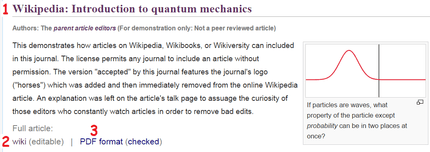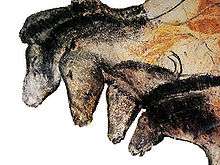Second Journal of Science/About
< Second Journal of Science| About | Current issue | Past issues | Publish | Peer reviewers | Editors | Editorial board | Contribute |
This journal provides students and instructors at or near the college or university level with concise articles that are focused to specific levels of education. It does not plan to publish scientific research or discussions on how to teach. While editors are committed to having each article reviewed by at least one person familiar with the subject, this is not a traditional peer-reviewed journal.
This journal can accept submissions from any Wikimedia sister project, or even abridged versions of such articles. Each published article is available in both editable and uneditable forms, including a PDF format that is convenient for off-line viewing or paper-copy printing. The CC-by-SA license places well over 5 million articles in this journal's "in-box".
To help sustain our reputation, the Wikiversity Journals are contemplating the creation of a guild that would allow the journals to self-regulate themselves outside the usual (long-winded) wiki-way of making decisions. The guilds will have little or no power beyond that which they earn by maintaining their own reputation. But, by having a few editors and referees making the decisions wiki wiki, it is hoped that less time will be wasted.[1] To paraphrase Groucho Marx, this journal refuses to join any guild that would accept it. But we would apply for probationary membership in a well-respected guild, if such a guild existed. If you have impressive credentials, please consider helping create this guild.
Purpose of this journal
- To create resources that are "static" in that they will not be edited mid-course. One reason for preferring "static" documents is that the instructor is never certain that Wikipedia or Wikiversity resources won't evolve mid-course. The posting of documents that have been peer reviewed also frees the instructor from the chore of verifying the correctness of a Wikviersity or Wikipedia resoure, and it facilitates the development of a bank of quiz and exam questions (see Quizbank)
- To provide instructors with labs and demonstrations. Many labs and demonstrations cannot become Wikipedia articles.
- To attribute and credit individual authors for their efforts. This is especially useful for students at or near college graduation, who have yet to establish their reputations among the standard scholarly journals. We are attempting to implement the policy that least two experts will view and approve each accepted article.
- See Three ways to publish in this journal for instructions on how to submit or nominate an article for this journal.
Peer review
It is not important that a journal have the right policies regarding standards and refereeing procedures, but that policies are clearly stated, consistently followed, and if necessary, gradually improve.
This journal can publish three types of articles, and each will be reviewed differently:
- Traditional articles by single author or a collaborative team will be reviewed in the traditional manner.
- "Wiki"-articles (from any Wikimedia sister project) are those that were created amorphously by many editors. Virtually all articles on Wikipedia are wiki articles. These articles will be reviewed by the community at large.
- Abridged "wiki" articles are "wiki"-articles that have been copied (with proper attribution) and then abridged. The process for reviewing these articles has not been fully determined.
The first of three types of articles published in this journal are traditional peer-reviewed articles that were written by a single author or a team of authors in collaboration. The second and third type shall be referred to as "wiki-articles" that
Traditional article by a single author or collaborative team
If the manuscript seems like a likely candidate for acceptance by this journal, it will be peer reviewed by at least one qualified confidential reviewer (who is not the editor-in-chief). It is recommended that such articles be written in userspace to avoid having too many authors.
"Wiki"-article (from any Wikimedia sister-project)
Most Wikipedia articles are too comprehensive and diverse in reading level for students to use as instructional materials. But an article that is unusually focused in both content and reading level may be nominated for publication in this journal.
The manuscript will be "published" in one of the standard issues of this journal, with the caveat that the byline will indicated that it is "under consideration". A subpage will be made available for comments by any editor (including IP editors). If and when a consensus is reached, the words "under consideration" will be removed and the article will be fully "accepted". Or, the article will be rejected and removed from the "Past Issue".
- See this example of the community review in action.
Abridged "wiki" articles
The initial motive for creating this journal was frustration with Wikipedia articles that contained far more than was deemed useful for an introductory science course. Prospective creators of such abridged versions should be warned that it is much easier to declare that a Wikipedia article is to comprehensive than it is to trim it down to something students can use.
Although abridged-"wiki" articles probably represent the most significant category in this group, it is not clear how they will be reviewed. For the time being, they will be treated as "wiki" articles and subject to community review. They can be "rejected" by the community, but the protocol for "accepting" has not yet been formulated.
Each published article is presented in three versions

- Each article in this journal is presented in three versions. The numbers (shown in red) in this figure indicate:
- The title above the abstract links to a version stored in the article's history page that cannot be changed. It is the version of the article that was accepted by the journal.
- If the article is not an abridged version of a Wikipedia article,[2] a "wiki (editable)" version is available as the article in its current state. Typically the latest "wiki(editable)" current version is the best version, as most Wikipedia articles tend to improve.
- The PDF is a completely stable and printable version of the article as it was accepted by the journal.
- None of the articles in this "zeroth" issue of this journal have been subject to peer review (i.e., "refereed"). The zeroth issue is for demonstration purposes
- The editorial board of this journal believes more journals like this should be constructed. See Wikiversity Journal/Starting a journal.
The name and logo

The original name of this journal was "First Journal of Science", chosen somewhat whimsically. The word "First" was in the spirit the practice in small towns in the US to designate churches and banks as "First", "Second", ..., and the intent was to invite other journals to form on Wikiversity. The word "First" was also selected because the journal is not a research journal, but focused on those "first" introductory courses often taken in the first two years of college.
The word "first" caused confusion, so the name was changed to "Second Journal of Science". This name was chosen primarily because it was an easy substitution for the templates, and also because Wikiversity's "first" journal is Wikiversity Journal of Medicine. The omission of "Wikiversity" in the name was deliberate: From Wikiversity, the link [[First Journal of Science]] makes it obvious that this is a Wikiversity journal. On Wikipedia or Wikibooks, the link would be [[Wikiversity:First Journal of Science]], which can be taken as an "onofficial" name for this journal.
If a guild emerges that requires a standardized name for this journal, two names come to mind: [[Wikiversity:Journal of Science Letters]] and [[Wikiversity Journal of Science Letters]].[3] It is fortunate that we have two similar names from which to choose, because the guilds should be decentralized as much as possible. This will permit the construction of two all-encompassing guilds, while allowing small informal guilds that include journals with names like [[Second Journal of Science]]
Timeline
- 9 January 2016: Construction of this page began, just as I was beginning write my 2015 Faculty Activity Report for Wright State University Lake Campus
- I Left message at Mikael_Häggström's talk page. He responded, joined the board of this journal and invited me to join the board of Wikiversity Journal of Medicine. My application is here.
- Applied and recieved ISSN registration.
- Wikipedia promotion: w:Wikipedia:WikiProject_Medicine/Wikiversity_Journal and w:User:Guy_vandegrift/Request_to_Wikipedia
- Announcement sent to w:Wikipedia:WikiProject_Science (See w:Special:Permalink/701903498#Scientific_Peer_Review)
- The zeroth edition contains this editorial
- 21:58, 5 February 2016 (UTC): Started Second_Journal_of_Science/Past_issues/Editorials/About_the_guilds
- 07:59, 12 February 2016 (UTC) created /Guilds
Wikimedia sister projects
| |
Wikipedia Free-content encyclopedia |
|
Wiktionary Dictionary and thesaurus |
|
Wikiquote Collection of quotations |
| |
Wikinews Free-content news |
|
Wikispecies Directory of species |
|
Wikibooks Free textbooks and manuals |
| |
Wikisource Free-content library |
|
Commons Shared media repository |
|
Meta-Wiki Wikimedia project coordination |
Links, Footnotes, and References
- w:Wikipedia:User pages is an important link that I believes gives us permission to keep abridged articles for publication here.
- Wikiversity Journal of Medicine was used as a template to create Second Journal of Science. There would be no Second Journal of Science if Wikiversity Journal of Medicine did not exist first.
- strategy:Proposal:Journal (A peer-review journal to allow/encourage academics to write Wikipedia articles)
- w:Wikipedia_talk:WikiProject_Medicine/Wikiversity_Journal Not directly related to the this journals proposed purpose, but related in that we are closely affiliated with Wikiversity Journal of Medicine
- Wikiversity_Journal Edited by the editor-in-chief of Wikiversity Journal of Medicine
- See also 699028781 for some ideas I jotted into my sandbox late at the night as I was convincing myself to start this journal.--Guy vandegrift
- ↑ In contrast with the situation on a Wikipedia article, where much thought must be given to the exclusion of information, the editor who is seeking to publish focused and readable articles must make snap judgments. To compensate, we many journals just like this one.
- ↑ Abridged versions of Wikipedia articles usually reside in Wikipedia userspace, where the propriety of group edits is not yet understood by this journal.
- ↑ The name Wikiversity Journal of Science Education should be reserved so as to also include articles on how to teach science. Such articles are not envisioned for this journal.
